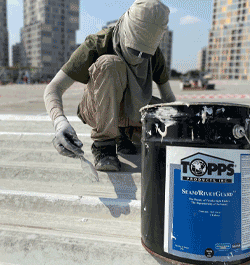UP TO THE MINUTE
Enhancing the safety and efficiency of your roofing company's fleet

By Cotney Consulting Group.
Investing in a comprehensive fleet management program is not just about compliance; it's about creating a sustainable and safe working environment that benefits your business in the long run.
A roofing contractor's commercial auto fleet is essential to the success of their business. Minimizing vehicle downtime, lengthening asset lifespan and reducing the frequency and severity of accidents are critical objectives for any roofing company. Implementing fleet management best practices, including driver selection, training and maintenance, is crucial for achieving these goals. Here's a comprehensive guide to help you optimize your fleet management program.
Driver selection
Selecting skilled and reliable drivers is the first step in ensuring the safety and efficiency of your fleet. Establish clear parameters for acceptable age, experience and driving records to guide your hiring process.
- Age: Younger drivers are generally less experienced and may be more likely to be involved in at-fault accidents. Setting a minimum age requirement can help mitigate this risk.
- Experience: It's essential to assess how long a driver has been licensed rather than assuming they began driving at 16. Ensure candidates have specific experience with the types of vehicles they will be operating.
- Driving record: Establish a written protocol for evaluating driving records. Before hiring, check each driver's Motor Vehicle Record (MVR) and compare it against your criteria. Annual checks of driving records are essential, along with appropriate disciplinary actions for violations or at-fault accidents. Consult with an employment law attorney to ensure your procedures comply with legal requirements.
Your insurance agent can also assist in developing driver acceptability guidelines that align with your insurance carrier's standards.
Training
Once drivers are hired, ongoing training is essential to maintain safety standards. Regular training sessions should cover key topics such as:
- Defensive driving: Emphasize not following too closely, avoiding distracted driving (texting while driving increases accident risk by 23 times) and not speeding. Address recognizing and responding to road rage.
- Healthy habits: Teach drivers to avoid fatigue, maintain overall health and stay alert on the road.
Safety incentives can help reinforce these training topics and encourage defensive driving practices.
Fleet maintenance
Older vehicles may present more maintenance challenges, but regular maintenance schedules are crucial regardless of vehicle age. Follow these best practices to keep your fleet in top condition:
- Regular maintenance schedule: Whether you use an in-house mechanic or an external service, maintain your vehicles regularly. Verify that external mechanics carry the necessary liability insurance and can adhere to your maintenance schedule.
- Safety devices: Equip vehicles with GPS, cameras or telematics to monitor location and driving behavior. These devices can also help determine faults in accidents.
- Pre- and post-trip inspections: Require employees to perform inspections before and after using a vehicle. This practice helps identify potential issues before they become serious problems.
- Lead by example: Management should also perform pre-trip inspections, demonstrating the importance of safety protocols to all employees.
Why these practices matter
Implementing driver acceptability guidelines, comprehensive training and stringent fleet maintenance protects your company's reputation and bottom line. Regular maintenance and inspections help identify concerns early, preventing costly accidents and prolonging the lifespan of your vehicles.
Monitoring and adjusting your fleet management program
Establishing a robust driver and fleet management program is the first step. Ongoing monitoring and adjustments are crucial to ensure the program's effectiveness. Enforce policies consistently to maintain high safety standards and operational efficiency.
Continuous improvement in fleet management
The commitment to fleet management doesn't end with establishing initial guidelines and practices. Continuous improvement is key to avoiding potential issues and adapting to new challenges and technologies. Here are some additional strategies to ensure your fleet management program remains effective and evolves with your business needs:
Regular review and updates
- Policy review: Regularly review and update your fleet management policies to reflect changes in regulations, technology and industry best practices. Involve key stakeholders in these reviews to ensure comprehensive updates.
- Driver feedback: Gather feedback from your drivers about the current fleet management practices. Their on-the-ground insights can be invaluable in identifying areas for improvement.
- Technology integration: Stay informed about new technologies that can enhance fleet safety and efficiency. This could include advanced telematics systems, improved GPS tracking or new vehicle safety features.
Enhanced training programs
- Advanced training modules: Offer advanced training sessions for experienced drivers to cover more complex topics such as handling hazardous materials, advanced defensive driving techniques and response to emergency situations.
- Refresher courses: Implement regular refresher courses to ensure all drivers remain up-to-date with the latest safety protocols and best practices.
- Simulation training: Use driving simulators to provide hands-on experience in a controlled environment. Simulators can replicate challenging driving conditions and help drivers practice their responses.
Proactive maintenance strategies
- Predictive maintenance: Use data analytics and telematics to predict when a vehicle will need maintenance based on its usage patterns and performance data. This proactive approach can prevent breakdowns and extend the lifespan of your fleet.
- Fleet rotation: Regularly rotate your vehicles to balance the wear and tear across your fleet. This ensures that no single vehicle is overused and helps maintain a consistent level of performance and safety.
- Comprehensive inspections: Go beyond basic inspections and include comprehensive checks of critical systems such as brakes, tires and engine components. Early detection of issues in these areas can prevent major problems and ensure vehicle reliability.
Promoting a safety-first culture
- Safety committees: Establish safety committees that include representatives from different levels of the organization. These committees can lead safety initiatives, review incident reports and recommend improvements.
- Safety recognition programs: Recognize and reward drivers who consistently follow safety protocols and maintain clean driving records. Positive reinforcement can encourage a culture of safety and accountability.
- Open communication channels: Maintain open communication channels where drivers can report safety concerns, near-misses and suggestions without fear of reprisal. This transparency can lead to continuous safety improvements.
Conclusion
Effective fleet management is a continuous process that requires attention to detail, commitment to safety and a willingness to adapt to new technologies and practices. Implementing the best driver selection, training and maintenance practices for roofing contractors can significantly reduce accidents, prolong vehicle lifespan and improve operational efficiency. By fostering a culture of safety and continuous improvement, you can protect your assets, ensure the safety of your employees and maintain a competitive edge in the industry.
Investing in a comprehensive fleet management program is not just about compliance; it's about creating a sustainable and safe working environment that benefits your business in the long run. Stay proactive, stay informed and prioritize safety to drive your roofing company toward success.
Learn more about Cotney Consulting Group in their Coffee Shop Directory or visit www.cotneyconsulting.com.



















Comments
Leave a Reply
Have an account? Login to leave a comment!
Sign In